Ecommerce SEO:
An Advanced Guide to Ecommerce SEO Strategy


According to Google’s research, 63% of shopping experiences begin online. Even more, 84% of Americans search for a shopping-related product every 48 hours!
Today, online stores face an unbelievable number of unique challenges in organic search. For one, organic listings, especially for head terms, are already incredibly competitive.
In addition, the SERP (search engine results page) is crowded with SERP features from video carousels, product ads, brand refinements, and more. The user’s attention is divided between too many opportunities and an improvement in rank position doesn’t always mean clicks.
Add to that the complexity of website technology and the user experience, making it difficult to keep the user interface simple and page load time low.
Recommended Reading: Google Shopping SEO: How to Driving Organic Search Traffic
However, the biggest challenge is so many teams involved in the process of SEO - online merchandisers, product owners/buyers, user experience teams, IT, paid search marketers and other digital marketing teams, and more.
Each of these teams has varying priorities and they work within their own tools.
As a result, there is no way to see the big picture of the website’s performance — SEOs lack a single place where they can access the truth in the data that benefits all teams.
The most important job for an SEO is to make sure that everyone is focused on the same metrics that benefit everyone’s goal.
But given the complexity of ecommerce SEO strategies and the typical ecommerce site architecture, delivering successful campaigns without that single source of truth is near impossible.
After all, how can you make successful decisions across teams without analyzing the exact same dataset?
In this guide, we’ll show you two things:
Let's begin!
When we analyzed more than 500 sites and 19 billion clicks we found that close to a third of the traffic to sites was driven by organic search.
“SEO is still the most important source of traffic to almost all websites.”
In addition to traffic, a solid SEO strategy for your ecommerce site will also work to create a more positive user experience.
In fact, at seoClarity, we say that SEO stands for search experience optimization since your main goal is to deliver the best search experience for your user, not chase down some ambiguous algorithm.
All of this builds on each other to drive organic traffic, captivate searchers when they land on your site, earn their conversion, and potentially turn them into repeat customers.
SEO for ecommerce is a powerful way to earn search visibility and score conversions, but it’s also a complex undertaking.
One consideration to be mindful of is personalized content — different parts of a website being shown to different users based on specific user profiles.
Personalized content for ecommerce sites can be device detection, local information relevant to a user, determining the user’s age and gender, language preferences, and location.
While personalized content can work to intrigue a user and capture their attention, it poses some risks for SEO…
“If these challenges are not taken into consideration from the very beginning they can cause sites to have issues ranging from reduced crawling and indexation issues, to losing keyword relevance and topical dominance.”
Another consideration with ecommerce SEO is the structure of your website, especially with implementing something like faceted navigation.
Faceted navigation lets users pare down product or service offerings with filters (think price, size, color, etc.) which is a huge benefit for the end user.
Unfortunately, this can result in mass amounts of duplicate content, especially at the enterprise level where there could be thousands of product offerings.
Again: fear not! We’ll cover both of these challenges down below.
A successful ecommerce SEO strategy involves seven critical elements:
As you’ll see shortly, all of those elements are connected and either of them influences the rest.
Overall, however, each forms a different stage of the process.
For that reason, we’ll go through them in the order I’ve listed above.
Keyword research is the backbone of every SEO strategy, and the situation is no different in ecommerce.
If you want to be profitable, your SEO strategy must begin with finding the most profitable keywords and phrases to rank for.
The process we always recommend to all of our clients involves focusing on five actions:
There are three things you must keep in mind when conducting ecommerce keyword research to discover the specific phrases online shoppers use.
ONE: In ecommerce, you deal with two levels of keywords: product-level and category-level. Each relates to a different type of content on the site: product pages and category pages.
THREE: Look beyond search volume. Head terms offer the greatest opportunity in search. Their search volume is high and positioning your domain on the first page would guarantee high traffic levels. Not to mention that they describe your product or category in the most straightforward way leading to relevant visitors.
However, most big players in your niche already occupy those SERPs.
Take a look at the example below to see domains selling “promise rings” that would be hard to compete with. Top brands and a very competitive SERP.
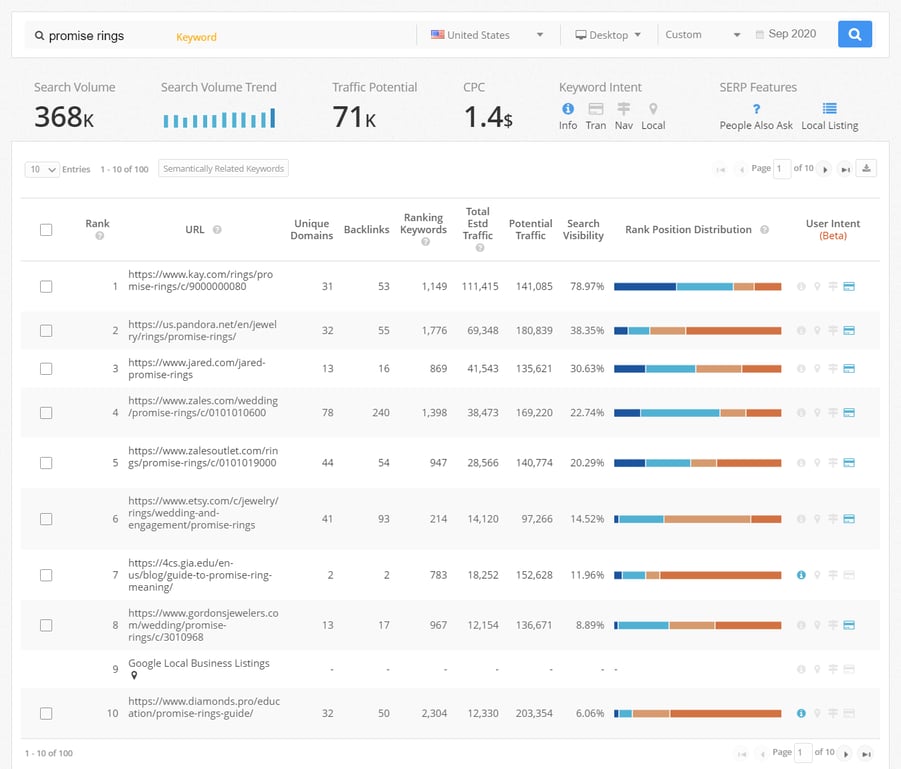 (seoClarity’s Research Grid results for “promise rings”.)
(seoClarity’s Research Grid results for “promise rings”.)
If you look through the results, most are transactional, but there are a few that have informational intent. Google’s Local Business Listings is an opportunity as well.
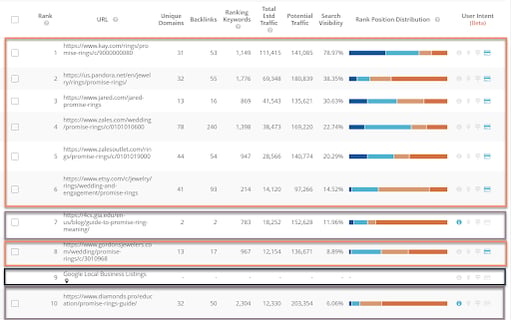
Locate opportunities that help searchers discover your brand along their buyer's journey while they research and look for promise rings.
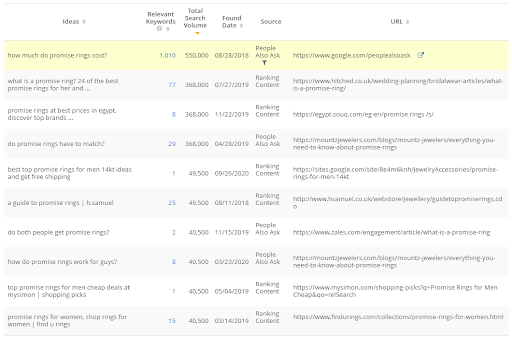 (seoClarity's Content Ideas for "promise rings".)
(seoClarity's Content Ideas for "promise rings".)
User experience plays an incredible part in SEO success today. In fact, at seoClarity, we say that SEO stands for search experience optimization since your main goal is to deliver the best search experience for your user.
Site architecture and the structure of your site are integral for SEO and the search experience.
Your pages stand a much greater chance at ranking if they contain the right content for the keyword. Similarly, where they are in the site taxonomy will affect their performance in the organic search.
For example, when planning the site’s architecture, you want product pages to rank for long-tail keywords with transactional or commercial intent. This way, potential customers can easily discover your brand and products through organic search.
Long-tail keywords attract customers that are almost at the end of the search funnel. As a result, a greater percentage of them will be likely to buy from you.
Category pages, on the other hand, allow you to reach the audience for shorter head terms.
In fact, in our joint research with JumpFly we discovered that ecommerce category pages present a far greater opportunity to deliver traffic and rankings than product pages.
Specifically, the category pages of ecommerce sites ranked for 19% more keywords compared to product pages. Those additional keyword ranks drove a surge of traffic to the category pages. This research was done for nearly 50 of the top ecommerce sites in the United States.
One other aspect of category pages that you can use to your advantage in your SEO strategy is multi-faceted navigation.
In short, faceted navigation allows users to filter down the search results on an ecommerce site to discover the specific products they’re looking for.
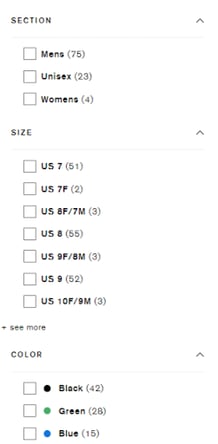
(Faceted Navigation on a footwear website.)
But given that, more often than not, faceted navigation creates separate URLs for filtered results, it allows Google to index those filtered pages. As a result, organic visitors can land directly on the page including products they’ve been searching Google for.
However, multi-faceted navigation can generate problems for Google in crawling and indexing. If each filter creates a new URL on the site without matching a demand.
Google might pick those up, leading to the search engine crawling unnecessary URLs and indexing duplicate content. While being very useful to users to be able to filter to the specific products they want.
You don’t want to have useless pages indexed by Google. Here’s the details on how to audit and implement faceted navigation to ensure that your site has been correctly implemented to help rather than hurt your SEO.
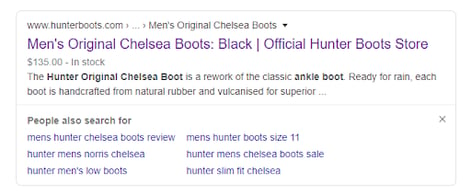 (SERP results take searchers to a specific product page.)
(SERP results take searchers to a specific product page.)
Ecommerce SEOs face unique challenges when optimizing for on-page SEO.
When working with a typical online retail website, you face a different, more complex site architecture or the type of information included.
Ecommerce sites include far more templates to cover different page types, making the process more complex as well.
Overall, however, the most critical on-page SEO elements to focus on ecommerce site include:
But here’s where things are different: by their nature, ecommerce sites include thousands of pages – if not more. Some of those URLs are static, others, as we’ve discussed when talking about faceted navigation, the site creates dynamically.
Recommended Reading: 17 Tips for Ecommerce SEO: Optimizing Product and Category Pages
One of the common challenges we see with ecommerce sites are duplicate page titles and meta descriptions for many pages.
The sheer amount of them makes it almost impossible to optimize them all by hand.
That’s why we recommend SEOs develop formulas for the most common on-page SEO elements like page titles and meta descriptions.
This way, they can create fully-optimized pages at a scale without having to worry about optimizing each one individually.
Technical SEO encompasses all the processes required to ensure that search engine crawlers can access, render, index, and rank the website and its pages.
Common technical SEO issues involve slow page speed, complex website technology, content rendering issues, poor keyword targeting, and more.
This should no longer have to be mentioned, but we still come across this with ecommerce sites from time to time. If your site hasn’t moved to HTTPS, stop reading this guide and figure out how to get that prioritized right away.
Unfortunately, ecommerce sites are vulnerable to certain technical SEO problems. We recommend reviewing this advanced SEO audit checklist for a full list. We will cover the main issues here:
As you’ve seen from sections above, online retail sites tend to generate many URLs dynamically. These could come as a result of having faceted navigation, or they happen because the site uses technology like the GET method in forms.
All in all, those pages contain similar content but they differ in the URL. To the search engine, therefore, they can look like duplicates.
Deep site taxonomy is another issue. Many pages on ecommerce sites get buried deep in the architecture, making them almost inaccessible within the site’s available crawl budget.
Broken links, both internal and external, can prevent crawlers from accessing all pages on your site. Not to mention that they provide a poor user experience, and that, in turn, could affect your rankings, organic traffic, and the conversion rate.
Page speed directly affects conversions on a page. Kissmetrics load time research notes that if a page takes longer than 3 seconds to load, more than a quarter of users will click away. In the same study, Walmart.com reports that with every second of increased page speed, they saw a two-percent boost in conversion.
Page speed is measured in several ways - load time, page size, time to first byte (TTFB), and round trip time (RTT).
A few of the top factors that slow down page speed are:Read our full guide to page speed, ways to remedy page speed, and how to measure and monitor it at scale.
Many ecommerce websites I encounter suffer from unnecessary URL redirects or too many redirect chains. There are a few best practices to improve this issue if this plagues your ecommerce site:
Focusing on technical SEO helps to identify and then eliminate those issues. Naturally, the process of elimination may involve rewriting parts of the code or optimizing the server setup. However, doing so will be critical to the site’s success in organic search.
To find technical SEO issues, run a crawl on your website. Many site audit and crawler tools exist, but at seoClarity, our site audit and crawler tool have no limits on the number of pages you can crawl or audits you can execute – even if your site is millions of pages.
Plus, it checks your site for more than 100+ technical health checks and provides you with clear actionable reports so you can resolve the issues quickly so you can create a better search experience for your users.
Recommended Reading: A Guide to Crawling Enterprise Sites Successfully
Within the realm of technical SEO is the schema markup. So what is schema for SEO? Essentially, it allows search engines to have a better understanding of your webpages’ content, and increases your search visibility on the SERP.
Examples of schema include the FAQ schema markup and company contact information in the Knowledge Panel, but for ecommerce sites specifically, Product, Star Rating, and Review schema can be quite beneficial in driving visibility (and increasing pixel real estate on the SERP).
Recommended Reading: A Look at Product & Review Schema for Ecommerce SEO
The image below shows two search engine results for the query “best running shoes.” Even though one listing is higher on the SERP than the other, which one would you be more likely to click?
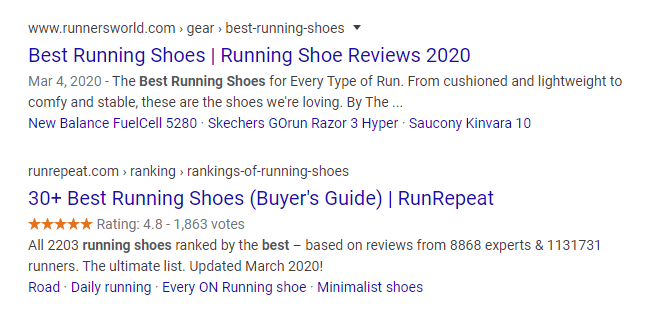 (Search listing that features the Star Schema.)
(Search listing that features the Star Schema.)
You probably answered with: the second. Its Star Schema attracts the eye and proves a social validation that other people find this listing useful. Incorporating the schema markup can mean improvement in CTR and in conversion rates.
Link building may be the most difficult element of the six on this list.
That's because building links to ecommerce sites is not as simple as when you do it for B2B content.
For one, most content you build links to in ecommerce are money pages. These could be product pages, category pages, holiday landing pages and so on.
Unfortunately, not many people want to link out to assets like that.
Recommended Reading: How to Build Backlinks Without Creating Content Chaos
However, the same people wouldn’t have a problem with referencing a blog post or any other informational content.
Of course, that doesn’t mean that you can’t build links to money pages. You just need specialist knowledge and experience to do so.
All in all, though, we thought we’d share some strategies that can help you acquire links to an ecommerce site organically.
This is by far the most effective strategy, although a bit time-consuming.
Research your top competitors’ link profiles to identify links you could recreate with ease. These would include guest posts you could place as well, ecommerce site listing, business directories, or product reviews.
Backlinks in our Research Grid, for example, allow you to evaluate links for any domain.
 (Backlinks report within the Research Grid.)
(Backlinks report within the Research Grid.)
Another great way to acquire links naturally is by sending your products out for reviews. Many bloggers, magazines, and other online outlets are open to reviewing products.
Sometimes, however, they do charge for the review so be prepared to have a budget or even free products for those submissions.
Admittedly, this isn’t the strongest link type. That said, if you’re only looking to start building links, then, submitting your site to CSS galleries can provide you with some easy do-follow backlinks fast.
Not every media outlet will link to a company when referencing their brand. Often, they’ll mention the company’s name and the product but fail to link back to their site. This is a great opportunity to acquire some initial backlinks as well.
Use a brand monitoring tool to find all your company’s mentions online. Review those, looking for references without a link. Then, contact the site’s editor, asking for the inclusion of the link.
Granted, not everyone will respond to the request positively. But some people will, sending you nice backlinks in the process.
Join any online forum that focuses on products like yours. The chances are the forum allows you to create a profile with a link (although it can have a no-follow attribute).
Plus, if you become active, you might get a chance to include a link to some of your product pages or other content.
In this case, the situation is quite different. Since your articles are, most likely, informational in nature, you have more opportunities to build links to them.
Some of the strategies you could use include:
The skyscraper technique: this is a complex strategy that, in a nutshell, works like this: you research the top-ranking content for your target keyword, then you create a much better asset on the same topic. Finally, you reach out to all the people who’ve linked to the original top-ranking page, suggesting your content as a much better resource.
Outreach for influencers or guest posts: pitch a topic to a site you’d like a link from. If they agree, you get to publish your content on their site, including links back to your blog posts and your homepage.
Guesting on podcasts: you can also ask to be a guest on podcasts that are centered around your target industry. Most shows feature notes that include links to any resources mentioned during the show, as well as the guest’s website (i.e. your store).
We’ve been mentioning content a lot throughout this guide. And this final element deals with the process of creating such content to drive rankings, conversions, and engagement.
But when it comes to ecommerce, SEO content writing focuses on two distinct areas:
Although there are many other page types on a typical ecommerce site, the two primary drivers of relevant organic traffic are product listing pages and category pages.
Both of them offer an opportunity to add informational content to groupings of products that will satisfy both the user's and the search engine’s needs.
However, there are certain things to remember when writing this copy:
A typical blog on an ecommerce website plays a number of roles. This means that your content, be it blog posts, guides, or anything else that you intend to publish, must meet at least one of those objectives.
As an example of the latter, having content that presents top Valentine’s Day gifts to buy for the significant other around the holiday can attract shoppers looking for inspiration and products to buy.
The elimination of the use of multiple tools and the consolidation into a single SEO platform allows you to streamline your SEO and content marketing efforts because everyone works from a single, centralized source of truth.
seoClarity, an enterprise SEO platform, brings all of your SEO data, metrics, and capabilities into one accessible platform, all without artificial limits.
This unifies the different teams within your organization — from IT, merchandising managers, product teams, and content strategists — under that single source of truth in your site’s SEO data. What does this give you? Consistent, repeatable results.
We understand that between teams there are limited resources, different processes, and multiple systems. Plus, the SEO team needs to show success quickly and that requires the many different teams working together.
With a dedicated Client Success Manager and SEO Professional Services, seoClarity offers a unique approach to successfully bring together those disparate pieces and leverages our enterprise SEO management framework.
We call it the SEO Center of Excellence — it’s our proprietary approach that focuses on repeatable processes and specific workflows that allow your entire team to focus on the end user, not the search engines’ constant changes.